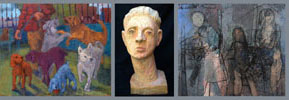Salena Gallery: Simon Carr, Mark LaRiviere, Thaddeus Radell Oct 17 - Nov 24, 2012 back
In the early 80s, Simon Carr, Mark LaRiviere and Thaddeus Radell all attended graduate school at the Parsons School of Design, in those years a Mecca for artists interested in rigorous, painterly figuration. They have remained in touch ever since, sometimes sharing studio space and drawing from hired models. The Salena Gallery’s current exhibition, consisting of nearly sixty works—paintings by Carr and Radell, sculptures by LaRiviere, as well as works on paper by all three—reveals what they’ve been up to over the last two years.
Whether painting scenes of frolicking dogs or subway car interiors, Carr catches, with a keen and sympathetic eye, ordinary but telling moments: the impatient gestures of a toddler in a stroller, a poodle worrying a small rubber ball, a face concentrating over the gleam of an iPhone. As anecdotes, the images intrigue, and Carr’s evocative, juicy brushwork and intense colors gratify the eye. But the artist imparts considerably more to these scenes; his strong sense of color and broad grasp of drawing impart a rare sense of gravity and scale. Though unnaturally intense in color, a spacious circulation of rust-orange, purple, ochre, and light blue vividly captures the tumbling energy of six dogs in the large canvas “Looking In” (2011). Poussin had his toga-clad denizens, Morandi his bottles; for Carr, the antics of canines—tugging, resting, sniffing, pouncing—become the occasion for lively, even grand, arabesques that catch the physical personalities of objects as only painting can. To various degrees, a similar scruffy brilliance illuminates an entire series of dog paintings, two still lifes, and a pair of large scenes of subway passengers.
LaRiviere, who now concentrates on sculpture after many years as a painter, proves himself equally adept at carving wood and shaping plaster (or actually Hydrocal, a modern substitute). The proportions of his nearly twenty heads, busts and figures are not strictly naturalistic, but their gestures ring true. In one grouping of six small, standing figures, not one stands in passive verticality; all lean, or twist, or reach out as if in greeting or conversation. With compact vigor, “Standing Woman 2” (2012, painted cast stone), holding a kind of heightened contrapposto, neatly captures the flow of weight from tilted head through angling shoulders, hips, and knees. Next to her, a man (2011, cast stone) draws himself back, the gesture heightened by the opposing hand clutched to his chest. Though impossibly inclined, the pose convinces. With similar energy, LaRiviere exploits the slight irregularities in some larger heads and torsos. Especially striking among them is the self-contained, moon-like face of “Large Head” (2012, wood), atop an improbably long neck.
Radell’s unusual painting medium—a mixture of oil and wax—accounts, on part, for the unique atmosphere of his vigorously reworked figure compositions and heads. His palette tends towards the gray-blues and greens, set off by terracotta-reds and an occasional lighter pink, all of them animated by dark, brushy, circling contour lines. Sensations of light, space, and form, however, emerge just as much from his raw, layered textures. Both the illumination and the subject matter of these paintings seem to arise from an internal meditation. The stately, measured poses of the seven figures in the large triptych “And the Dark Child Shines Bright” (2012)—rendered in weathered, scraped surfaces—evoke a time-worn vision of an ancient Greek frieze. Three paintings of heads, though smaller in their physical dimensions, hold their own; in these, Radell powerfully locates the denseness of their orbs, turning this way or that, dominating the thick space around them.
Works on paper by all three artists fill a corner of the gallery. Some of LaRiviere’s lively ink drawings of figures represent, perhaps, the first drafts of his three-dimensional ventures in wood and Hydrocal. Rich tones cast an evocative light about Carr’s etchings and woodcuts of figures, animals and flowers. Veils of delicate, scratchy lines lend a limpid depth to Radell’s drawings after master paintings. This is only appropriate, as visions of great traditions—coalesced in those long-ago years at Parsons—resonate throughout the exhibition.
Salena Gallery
LIU Brooklyn Campus
1 University Plaza, Brooklyn NY 11201
718-488-1198
